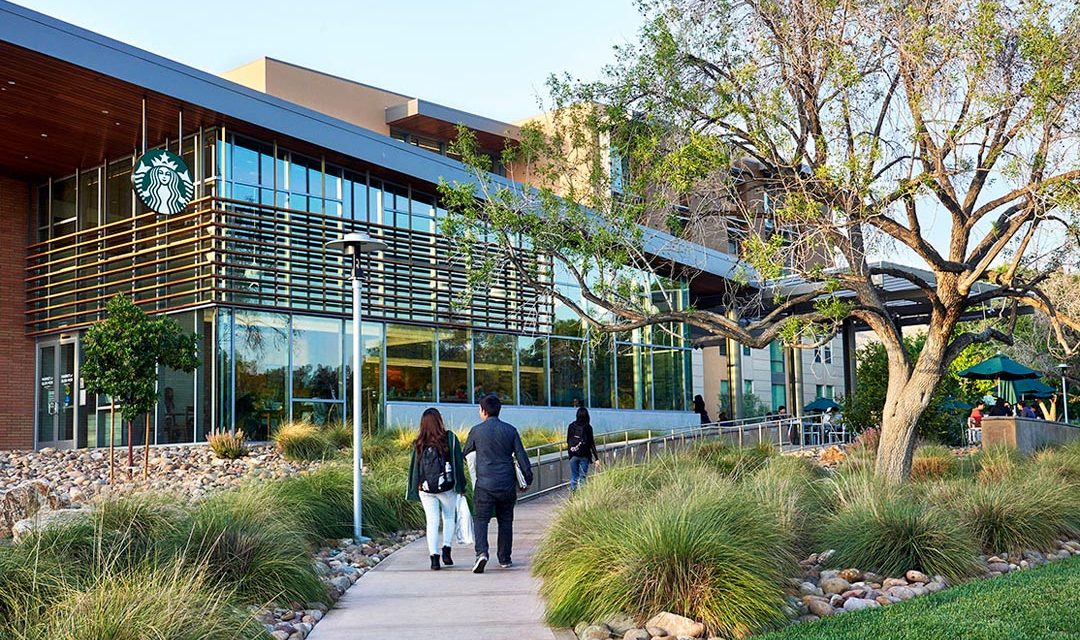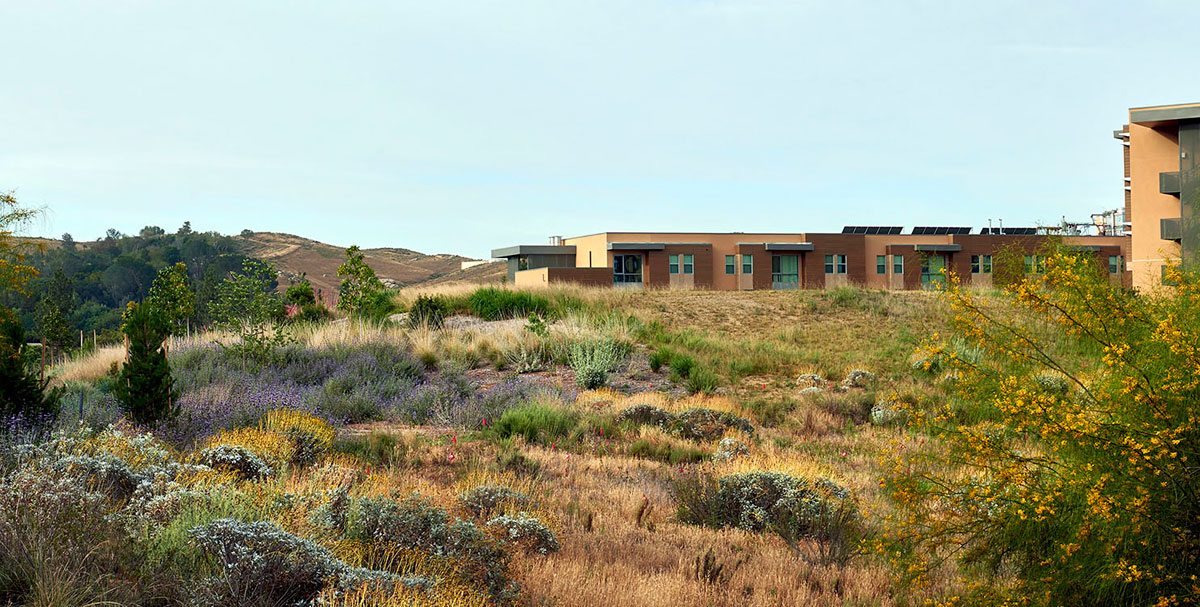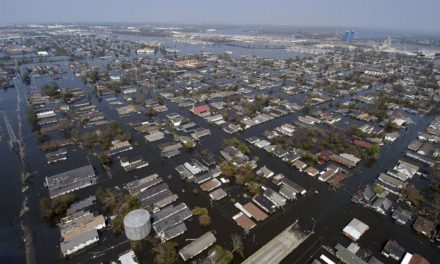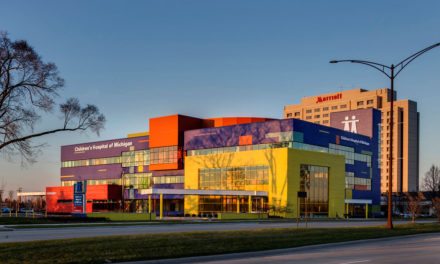A recent housing complex at the University of California, Riverside makes a case for change by challenging the language of conventional university landscape typologies. Glen Mor Student Apartments sets the stage for an academic experience grounded in place. The design embraces changing attitudes about sustainability, offers an appropriate response to building in arid climates, and taps into students’ shifting sensitivities and increased climate-awareness.
Founded in 1907 as an agricultural research station by the State of California, this remained the focus until it became a fully-fledged university in the latter half of the 1950s. Adopting the conventions of academic design, the campus landscape developed as a mix of courtyards and quads planted with trees and lawn. Continued enrollment growth at the University led to a multi-phased expansion of student housing, with Glen Mor as the latest addition, providing an opportunity to create a landscape more in sync with its high-desert ecology.
The nearly 20-acre, student-housing site occupies a ridge line at the edge of the foothills to the nearby Box Spring Mountains, considered an ecotone zone between coastal sage scrub and chaparral ecologies. Seeking to ground this new complex in its historic and geographic context, the design embraces the site’s heritage through a vocabulary of contrasts. Throughout the site, rectilinear geometries of its agricultural legacy are paired with the fluid geometries of a restored arroyo and the surrounding landscape.
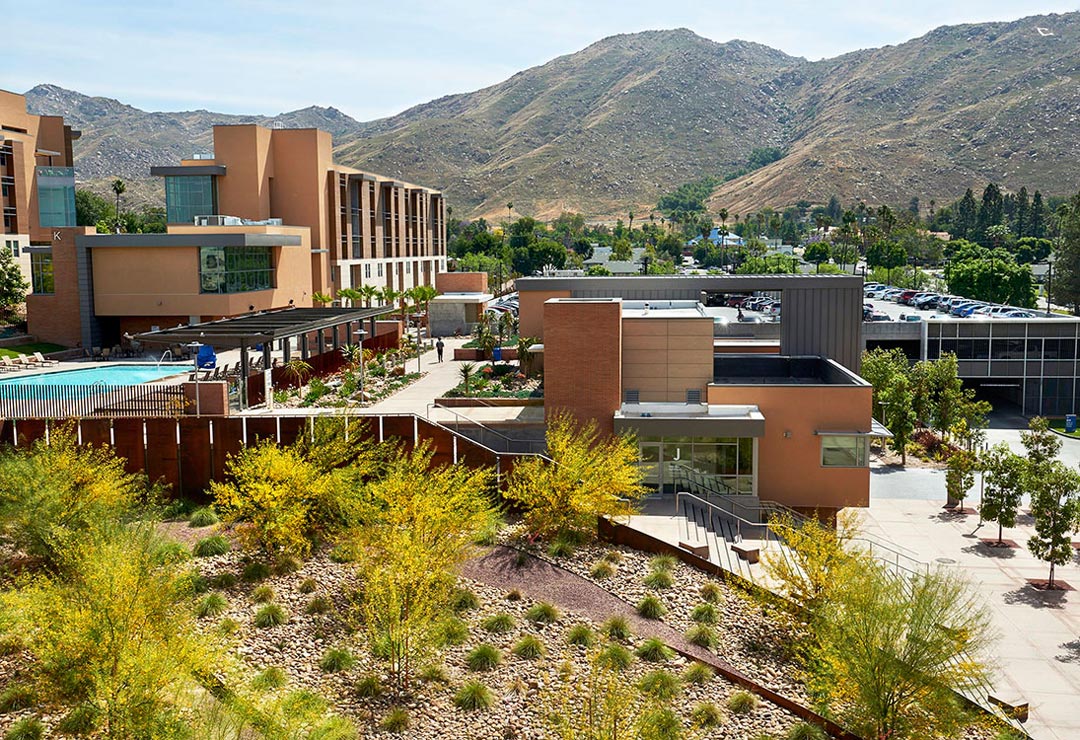
Palo verde garden, grand stair, weathering steel retaining wall to upper terrace and pool succulent garden. Box Springs Mountains in background. Photo: Millicent Harvey
The centerpiece of the intervention is the arroyo. Previously a marginalized edge, the 4.6-acre arroyo now takes center stage, becoming a physical and symbolic focal point for the expanding campus and a refuge for students and nature. Punctuated with gabion retaining walls and planted with riparian, drought-tolerant native plants, the channel becomes a seasonal reminder of natural change. A simple, weathering steel-truss pedestrian bridge connects the Glen Mor housing complexes, while a series of meandering pedestrian paths enable students to explore the landscape, find tranquil places to study, or meet with friends.
Infrastructure merges with ecosystem, resulting in an experiential laboratory where students absorb the lessons of nature first hand. A forty-foot change in elevation across the site provides opportunities for enhanced visual connections with the surroundings. The project’s courtyards and terraces feature species from the arroyo, including palo verde trees in the high-dessert garden, deer grass and red yucca in the seating terrace, California sycamore groves in the plaza, and coast live oaks sprinkled throughout the campus as specimen trees. On the ground plane, deer grass serves as the dominant species, defining many of the pathways. Drifts of desert brittlebrush and white sage, characteristic of coastal sage scrub habitats, dot the landscape.
The local environment is reflected throughout the project, from the use of native and regionally adapted plant material to the integration of California gold cobblestones and boulders sourced from a nearby quarry. Strong contrasts within the landscape—texture, material, color—call attention to place, encouraging students and visitors to pause and take in the environment. The soft rust tones of the weathering steel, integrally-colored hardscape, and rocky ground plane create a striking backdrop for the rich and diverse plant palette. Materials were selected to weather with time and climate, in sync with the seasonal evolution of the surrounding mountains. The result is a regionally-specific, adaptable landscape capable of responding to changing conditions—a landscape that blurs the boundary between campus and region, connects past and present, and seeks to restore a natural balance to the community.
Contrasts also exist in the geometries used to organize the landscape design. A unique campus typology emerges where the traditional language of bosques, allées, and quadrangles of lawn yield to more unexpected forms and relationships between planting and landscape materials.
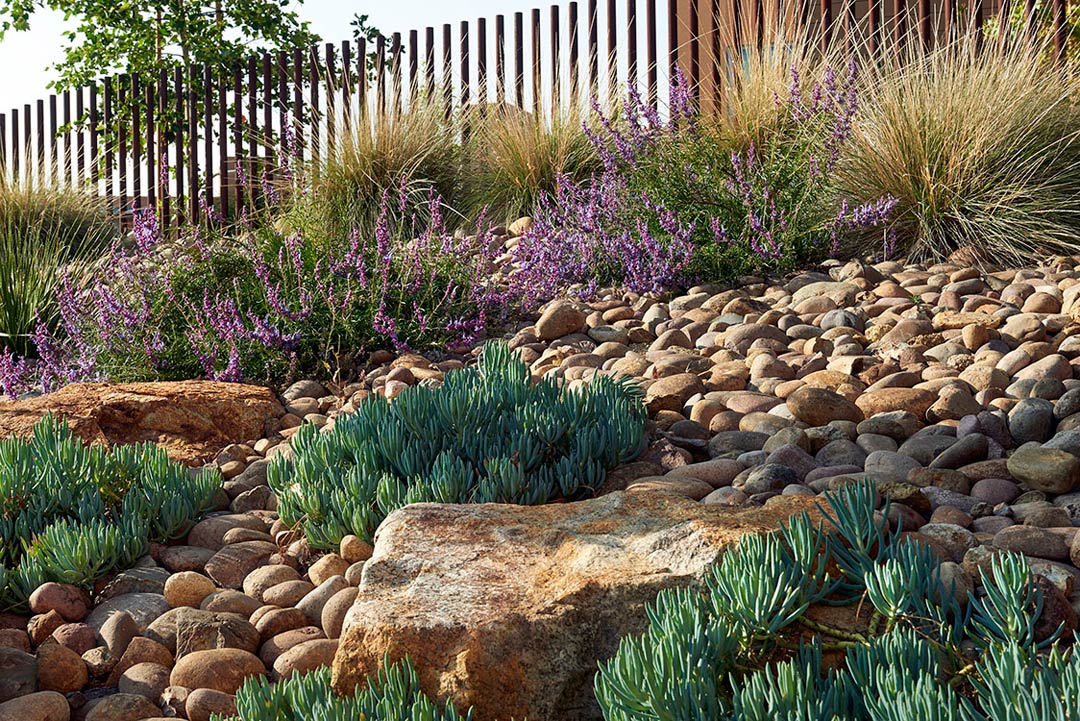
California gold cobble with Muhlenbergia rigen and Platanus racemosa planting. Photo: Millicent Harvey
Concurrent with the design of this project was a statewide university initiative to prioritize water and energy reduction. This timing, and the successful implementation of the arroyo project, has meant that it has become a prototype for future landscape design throughout the California university system.
“Students have responded by heavily favoring the Glen Mor Apartments. Every year there’s been a wait list. Students say they appreciate the connection to place and the greater landscape and find it a tranquil and peaceful place to which to come home,”
– Meghen Quinn, principal, Office of Cheryl Barton (this project was completed as Meghen Quinn Architects)
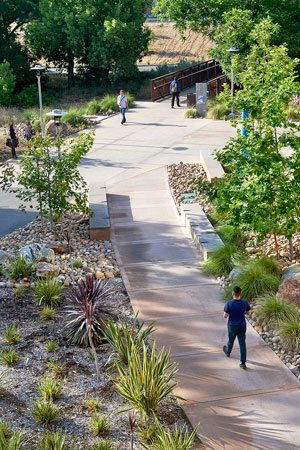
The Arroyo at Glen Mor Student Apartments – University of California, Riverside in Riverside, Calif. Photo: Millicent Harvey
Project Details
Total Project Area: 844,500 sf / 19.4 acres
Total Planted Area (including Arroyo): 492,230 sf / 11.3 acres
Arroyo Planted Area: 200,685 sf / 4.60 acres
Housing Core Planted Area: 182,235 sf / 4.20 acres
Lawn Used in Housing Core: 9,240 sf / 0.21 acres
Total Drought-Tolerant Planting: 382,920 sf / 8.8 acres / 78% of site
(there was a legacy landscape area of lawn which we replaced: 97,570 sf / 2.24 acres / 22%)
Design and Construction Team
Landscape Architect: Quinn Landscape Architects / Sasaki Associates
Architect: SCB Architects / Sasaki Associates
Structural Engineer: Saiful Bouquet
Civil Engineer: Flores/Lund
Irrigation Designer: Russ Mitchel Associates
Mechanical Engineer: Kailifeh Associates
Plumbing Engineer: Kailifeh Associates
Electrical Engineer: OMB Engineers
General Contractor: Clark Construction Group
About Meghen Quinn
Meghen Quinn provides expertise in conceptualization, design, and construction of institutional, commercial, and public landscapes of a variety of types and scales. Her project experience includes working with derelict and adaptive reuse sites, as well as performance-based site systems. Her work reflects a range of interests with a consistent focus on expressing the context of the site and its history, natural systems, and inhabitants.
Meghen founded Quinn Landscape Architects (QLA) in 2012. In 2017 Meghen merged QLA with Office of Cheryl Barton (O|CB) to help lead the design team alongside Founding Principal, Cheryl Barton, and Managing Principal, Paul Sieron. Meghen brings her portfolio featuring a range of urban and institutional projects, including the Chandran Gallery and Northside Park in San Francisco, and The Arroyo at Glen Mor Student Apartments at University of California, Riverside.

